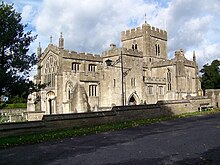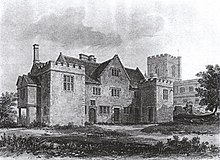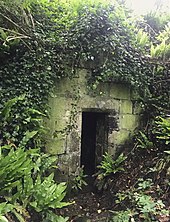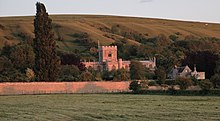Edington Priory: Difference between revisions
| (6 intermediate revisions by 3 users not shown) | |||
| Line 1: | Line 1: | ||
{{Use dmy dates|date= |
{{Use dmy dates|date=December 2022}} |
||
{{Use British English|date=May 2013}} |
{{Use British English|date=May 2013}} |
||
[[File:The Priory Church of St Mary, St Katharine and All Saints, Edington - geograph.org.uk - 1008817.jpg|thumb|The church in 2008]] |
[[File:The Priory Church of St Mary, St Katharine and All Saints, Edington - geograph.org.uk - 1008817.jpg|thumb|The church in 2008]] |
||
| Line 6: | Line 6: | ||
== History == |
== History == |
||
=== Early history === |
=== Early history === |
||
When Edington was recorded in [[Domesday Book]] of 1086 it was held by [[Romsey Abbey]].<ref>{{OpenDomesday|ST9253|edington|Edington}}</ref> The nuns of Romsey provided a church for their tenants at Edington.<ref name=friends>[https://www.edingtonfriends.org.uk/about-us/church-history/ Church History, Friends of Edington Priory Church]</ref> Remains of a late-[[Norman architecture|Norman]] church were found during restoration in the 19th century.<ref name="vch">{{cite web|website=British History Online|title=Victoria County History - Wiltshire - Vol 8 |
When Edington was recorded in [[Domesday Book]] of 1086 it was held by [[Romsey Abbey]].<ref>{{OpenDomesday|ST9253|edington|Edington}}</ref> The nuns of Romsey provided a church for their tenants at Edington.<ref name=friends>[https://www.edingtonfriends.org.uk/about-us/church-history/ Church History, Friends of Edington Priory Church]</ref> Remains of a late-[[Norman architecture|Norman]] church were found during restoration in the 19th century.<ref name="vch">{{cite web|website=British History Online|title=Victoria County History - Wiltshire - Vol 8 pp. 239–250 - Edington|url=http://www.british-history.ac.uk/vch/wilts/vol8/pp239-250|publisher=University of London|access-date=23 November 2015}}</ref> [[North Bradley]] was a [[chapelry]] of Edington at this time. |
||
=== William Edington === |
=== William Edington === |
||
| Line 12: | Line 12: | ||
=== Priory === |
=== Priory === |
||
In 1358 the chantry became a house of the [[Boni Homines|Bonhommes]], an [[Augustinians|Augustinian]] community. The establishment was modelled on [[Ashridge Priory]]. The chantry's property was transferred to the new foundation and William, with others, added many manors to its wealth until his death in 1366. The first rector, brought from Ashridge, was John de Aylesbury.<ref name="vchbh">{{cite web|website=British History Online|title=Victoria County History - Wiltshire - Vol 3 |
In 1358 the chantry became a house of the [[Boni Homines|Bonhommes]], an [[Augustinians|Augustinian]] community. The establishment was modelled on [[Ashridge Priory]]. The chantry's property was transferred to the new foundation and William, with others, added many manors to its wealth until his death in 1366. The first rector, brought from Ashridge, was John de Aylesbury.<ref name="vchbh">{{cite web|website=British History Online|title=Victoria County History - Wiltshire - Vol 3 pp. 320–324 - House of Bonhommes: Edington|url=http://www.british-history.ac.uk/vch/wilts/vol3/pp320-324|publisher=University of London|access-date=23 November 2015}}</ref> At the time of his death in 1382 the brethren were eighteen in number. |
||
[[John Rous (died c. 1454)]] gave the nearby manor of Baynton to the monastery, funding a chantry to pray for himself and his first wife; he was buried in the south aisle.<ref name="HoP">{{Cite web |last=Richmond |
[[John Rous (died c. 1454)]] gave the nearby manor of Baynton to the monastery, funding a chantry to pray for himself and his first wife; he was buried in the south aisle.<ref name="HoP">{{Cite web |last=Richmond |title=ROUS, John III (d.c.1454), of Baynton in Edington, Wilts. |url=http://www.historyofparliamentonline.org/volume/1386-1421/member/rous-john-iii-1454 |access-date=8 June 2022 |website=History of Parliament Online}}</ref> |
||
During [[Jack Cade]]'s rebellion in 1450, [[William Ayscough]], [[Bishop of Salisbury]] and confessor to [[Henry VI of England|Henry VI]], was forced to flee [[Salisbury]]. Seeking refuge in the church at Edington, he was discovered on 29 June, dragged from the high altar during mass and murdered in the fields outside the church.<ref name="HoP" /> |
During [[Jack Cade]]'s rebellion in 1450, [[William Ayscough]], [[Bishop of Salisbury]] and confessor to [[Henry VI of England|Henry VI]], was forced to flee [[Salisbury]]. Seeking refuge in the church at Edington, he was discovered on 29 June, dragged from the high altar during mass and murdered in the fields outside the church.<ref name="HoP" /> |
||
[[Paul Bush (bishop)|Paul Bush]] became provost of the house at Edington. In 1539 at the [[ |
[[Paul Bush (bishop)|Paul Bush]] became provost of the house at Edington. In 1539 at the [[dissolution of the monasteries]] the house was peacefully dissolved and the brothers given pensions for life. In 1541 most of its estates were obtained by [[Thomas Seymour, 1st Baron Seymour of Sudeley|Sir Thomas Seymour]].<ref name="vchbh" /> |
||
== Monastic remains == |
== Monastic remains == |
||
| Line 29: | Line 29: | ||
=== Priory remains=== |
=== Priory remains=== |
||
North and east of the church, two large rectangular gardens enclosed by walls approximately 3 to 4 metres high may reflect the layout of the monastic precinct. Orbach considers all their features to be from [[Jacobean era|Jacobean]] pleasure gardens, and places the shell-headed wall niches at c.1600.<ref name="Orbach">{{Cite book |last1=Orbach |first1=Julian |title=Wiltshire |last2=Pevsner |first2=Nikolaus |last3=Cherry |first3=Bridget |publisher=[[Yale University Press]] |year=2021 |isbn=978-0-300-25120-3 |series=The Buildings |
North and east of the church, two large rectangular gardens enclosed by walls approximately 3 to 4 metres high may reflect the layout of the monastic precinct. Orbach considers all their features to be from [[Jacobean era|Jacobean]] pleasure gardens, and places the shell-headed wall niches at c.1600.<ref name="Orbach">{{Cite book |last1=Orbach |first1=Julian |title=Wiltshire |last2=Pevsner |first2=Nikolaus |last3=Cherry |first3=Bridget |publisher=[[Yale University Press]] |year=2021 |isbn=978-0-300-25120-3 |series=The Buildings of England |location=New Haven, US and London |page=317 |oclc=1201298091 |authorlink2=Nikolaus Pevsner |authorlink3=Bridget Cherry}}</ref><ref>{{National Heritage List for England|num=1021493|desc=Remains of Abbey or Priory in grounds of The Monastery Garden |access-date=23 November 2015|fewer-links=yes}}</ref> |
||
[[File:Ladywell, Edington, 9 June 2018.jpeg|thumb|upright|Ladywell, Edington]] |
[[File:Ladywell, Edington, 9 June 2018.jpeg|thumb|upright|Ladywell, Edington]] |
||
=== The Monastery Garden Cottage=== |
=== The Monastery Garden Cottage=== |
||
Northeast of the church, on the road which leads to Steeple Ashton, a cottage named The Monastery Garden, possibly 16th century, is built into a stretch of wall which may have monastic origins.<ref>{{National Heritage List for England|num=1021492|desc=The Monastery Garden|access-date=23 November 2015|fewer-links=yes}}</ref> |
Northeast of the church, on the road which leads to Steeple Ashton, a cottage named The Monastery Garden, possibly 16th century, is built into a stretch of wall which may have monastic origins.<ref>{{National Heritage List for England|num=1021492|desc=The Monastery Garden|access-date=23 November 2015|fewer-links=yes}}</ref> |
||
| Line 40: | Line 41: | ||
== Notable people == |
== Notable people == |
||
[[William Wey]] (c.1407–1476), who made [[ |
[[William Wey]] (c. 1407–1476), who made [[pilgrimage]]s to Spain, Jerusalem, and Palestine, entered the monastery around 1463 and wrote his accounts of his travels there.<ref>{{cite DNB|wstitle=Wey, William|volume=60}}</ref> |
||
[[Paul Bush (bishop)|Paul Bush]], the last provost of the monastery, became from c.1539 a residentiary canon of Salisbury Cathedral, and from 1542 to 1554 the first [[bishop of Bristol]].<ref>{{DNB|wstitle=Bush, Paul|last=Venables|first=Edmund|volume=8}}</ref> |
[[Paul Bush (bishop)|Paul Bush]], the last provost of the monastery, became from c. 1539 a residentiary canon of Salisbury Cathedral, and from 1542 to 1554 the first [[bishop of Bristol]].<ref>{{DNB|wstitle=Bush, Paul|last=Venables|first=Edmund|volume=8}}</ref> |
||
== Parish church == |
== Parish church == |
||
[[File:Sunset on Edington Church - geograph.org.uk - 449417.jpg|thumb|The church and Priory House, under the scarp of Salisbury Plain]] |
[[File:Sunset on Edington Church - geograph.org.uk - 449417.jpg|thumb|The church and Priory House, under the scarp of Salisbury Plain]] |
||
<!-- Church of St Mary, St Katherine and All Saints, Edington redirects here --> |
|||
The church stands today, a good example of the transition between the [[decorated style|decorated]] and [[perpendicular style|perpendicular]] style of church-building. [[Nikolaus Pevsner|Pevsner]] writes "A wonderful church and a highly important church. It is so varied in its skyline and so freely embattled that it looks like a fortified mansion ...".<ref name="Orbach" /> It was listed at Grade I in 1968.<ref>{{National Heritage List for England|num=1364257|desc=Church of St Mary, St Katherine and All Saints|access-date=23 November 2015|fewer-links=yes}}</ref> |
The church stands today, a good example of the transition between the [[decorated style|decorated]] and [[perpendicular style|perpendicular]] style of church-building. [[Nikolaus Pevsner|Pevsner]] writes "A wonderful church and a highly important church. It is so varied in its skyline and so freely embattled that it looks like a fortified mansion ...".<ref name="Orbach" /> It was listed at Grade I in 1968.<ref>{{National Heritage List for England|num=1364257|desc=Church of St Mary, St Katherine and All Saints|access-date=23 November 2015|fewer-links=yes}}</ref> |
||
The whole 14th-century church survives, with its interior enhanced in the 17th century, and restoration by [[ |
The whole 14th-century church survives, with its interior enhanced in the 17th century, and restoration by [[Charles Ponting]] in 1888–91. Ponting also restored the limestone cross in the churchyard which may date from early in the 19th century.<ref>{{National Heritage List for England|num=1364258|desc=Churchyard Cross|access-date=21 June 2022|fewer-links=yes}}</ref> |
||
The church has medieval glass and contains the burial monuments of several local notables, including tombs removed from St Giles at [[Imber]] during the early 1950s, following the evacuation of that village in 1943.<ref>{{cite web|url=https://apps.wiltshire.gov.uk/communityhistory/Church/Details/1165|title=Priory Church of St. Mary, St. Katherine and All Saints, Edington |
The church has medieval glass and contains the burial monuments of several local notables, including tombs removed from St Giles at [[Imber]] during the early 1950s, following the evacuation of that village in 1943.<ref>{{cite web|url=https://apps.wiltshire.gov.uk/communityhistory/Church/Details/1165|title=Priory Church of St. Mary, St. Katherine and All Saints, Edington|website=Wiltshire Community History|publisher=Wiltshire Council}}</ref> |
||
The benefices and parishes of Edington and Imber were united in 1951, with the parsonage house at Imber to be sold.<ref>{{London Gazette |
The benefices and parishes of Edington and Imber were united in 1951, with the parsonage house at Imber to be sold.<ref>{{London Gazette |
||
| Line 56: | Line 58: | ||
| date = 7 December 1951 |
| date = 7 December 1951 |
||
| page = 6384 |
| page = 6384 |
||
}}</ref> Today the parish is part of the benefice of Bratton, Edington and Imber, Coulston and Erlestoke.<ref>{{cite web |title=BECIE Benefice |url=https://www.beciebenefice.org/index.html |access-date=29 June 2022 |
}}</ref> Today the parish is part of the benefice of Bratton, Edington and Imber, Coulston and Erlestoke.<ref>{{cite web |title=BECIE Benefice |url=https://www.beciebenefice.org/index.html |access-date=29 June 2022 }}</ref> |
||
In 1965 there were six bells,<ref name="vch" /> one of them dated 1647 and three from the 18th century; four more (sounding higher notes) were hung in 1968 to make a peal of ten.<ref name=":0">{{Cite web |title=Edington |url=https://dove.cccbr.org.uk/detail.php?tower=15138 |access-date=29 June 2022 |website=Dove's Guide for Church Bell Ringers}}</ref> There is also a sanctus bell.<ref name=":0" /> In 2014 a new organ by [[Harrison & Harrison]] was installed.<ref>{{cite web |date=10 January 2014 |title=Edington villagers help pack up organ bound for school in Estonia |url=https://www.wiltshiretimes.co.uk/news/10929281.edington-villagers-help-pack-up-organ-bound-for-school-in-estonia/ |access-date=23 November 2015 |website=Wiltshire Times}}</ref> |
In 1965 there were six bells,<ref name="vch" /> one of them dated 1647 and three from the 18th century; four more (sounding higher notes) were hung in 1968 to make a peal of ten.<ref name=":0">{{Cite web |title=Edington |url=https://dove.cccbr.org.uk/detail.php?tower=15138 |access-date=29 June 2022 |website=Dove's Guide for Church Bell Ringers}}</ref> There is also a sanctus bell.<ref name=":0" /> In 2014 a new organ by [[Harrison & Harrison]] was installed.<ref>{{cite web |date=10 January 2014 |title=Edington villagers help pack up organ bound for school in Estonia |url=https://www.wiltshiretimes.co.uk/news/10929281.edington-villagers-help-pack-up-organ-bound-for-school-in-estonia/ |access-date=23 November 2015 |website=Wiltshire Times}}</ref> |
||
Every August since 1956 a festival of church music, the Edington Festival of Music within the Liturgy, is held here.<ref>{{cite web|title=The Edington Festival of Music within the Liturgy|url=http://www.edingtonfestival.org/|access-date=23 November 2015}}</ref><ref>{{cite web|title=Edington heads for the limelight|url=http://www.bbc.co.uk/wiltshire/content/articles/2006/01/26/edington_priory_feature.shtml| |
Every August since 1956 a festival of church music, the Edington Festival of Music within the Liturgy, is held here.<ref>{{cite web|title=The Edington Festival of Music within the Liturgy|url=http://www.edingtonfestival.org/|access-date=23 November 2015}}</ref><ref>{{cite web|title=Edington heads for the limelight|url=http://www.bbc.co.uk/wiltshire/content/articles/2006/01/26/edington_priory_feature.shtml|publisher=BBC - Wiltshire|access-date=23 November 2015|date=29 October 2014}}</ref> |
||
==See also== |
==See also== |
||
| Line 77: | Line 79: | ||
==External links== |
==External links== |
||
{{commons category}} |
{{commons category}} |
||
* {{Official website|https://www.edingtonpriory.church/|The Parish of Edington and Imber}} |
|||
*[ |
*[https://www.bbc.co.uk/wiltshire/content/image_galleries/edington_priory_gallery.shtml Images from the BBC] |
||
*[https://web.archive.org/web/20190827000513/http://www.bayntun-history.com/BayntunMystery.htm Bayntun Tomb mystery] at bayntun-history.com, archived in August 2019 |
*[https://web.archive.org/web/20190827000513/http://www.bayntun-history.com/BayntunMystery.htm Bayntun Tomb mystery] at bayntun-history.com, archived in August 2019 |
||
*[http://www.wiltshirerecordsociety.org.uk/pdfs/wrs_v42.pdf The Edington Cartulary] – Janet H. Stevenson (1987), [[Wiltshire Record Society]] vol. 42 |
*[http://www.wiltshirerecordsociety.org.uk/pdfs/wrs_v42.pdf The Edington Cartulary] – Janet H. Stevenson (1987), [[Wiltshire Record Society]] vol. 42 |
||
| Line 85: | Line 88: | ||
[[Category:Augustinian monasteries in England]] |
[[Category:Augustinian monasteries in England]] |
||
[[Category:Monasteries in Wiltshire]] |
[[Category:Monasteries in Wiltshire]] |
||
[[Category:Church of England church buildings in Wiltshire]] |
|||
[[Category:14th-century church buildings in England]] |
|||
[[Category:Grade I listed monasteries]] |
[[Category:Grade I listed monasteries]] |
||
[[Category:Grade I listed churches in Wiltshire]] |
|||
[[Category:1332 establishments in England]] |
[[Category:1332 establishments in England]] |
||
[[Category:Christian monasteries established in the 14th century]] |
[[Category:Christian monasteries established in the 14th century]] |
||
Latest revision as of 00:13, 20 August 2023

Edington Priory in Wiltshire, England, was founded by William Edington, the bishop of Winchester, in 1351 in his home village of Edington, about 3+3⁄4 miles (6 km) east of the town of Westbury. The priory church was consecrated in 1361 and continues in use as the parish church of Saint Mary, Saint Katharine and All Saints.
History[edit]
Early history[edit]
When Edington was recorded in Domesday Book of 1086 it was held by Romsey Abbey.[1] The nuns of Romsey provided a church for their tenants at Edington.[2] Remains of a late-Norman church were found during restoration in the 19th century.[3] North Bradley was a chapelry of Edington at this time.
William Edington[edit]
William Edington (d. 1366), from an Edington family, became Treasurer of England and bishop of Winchester, and founded a college of chantry priests at Edington in 1351[2] in order to have prayers said for himself, his parents and his brother. The church was transferred from Romsey to the chantry, and William gave further funds and properties in the following years.
Priory[edit]
In 1358 the chantry became a house of the Bonhommes, an Augustinian community. The establishment was modelled on Ashridge Priory. The chantry's property was transferred to the new foundation and William, with others, added many manors to its wealth until his death in 1366. The first rector, brought from Ashridge, was John de Aylesbury.[4] At the time of his death in 1382 the brethren were eighteen in number.
John Rous (died c. 1454) gave the nearby manor of Baynton to the monastery, funding a chantry to pray for himself and his first wife; he was buried in the south aisle.[5]
During Jack Cade's rebellion in 1450, William Ayscough, Bishop of Salisbury and confessor to Henry VI, was forced to flee Salisbury. Seeking refuge in the church at Edington, he was discovered on 29 June, dragged from the high altar during mass and murdered in the fields outside the church.[5]
Paul Bush became provost of the house at Edington. In 1539 at the dissolution of the monasteries the house was peacefully dissolved and the brothers given pensions for life. In 1541 most of its estates were obtained by Sir Thomas Seymour.[4]
Monastic remains[edit]

The site of the monastery, north and northeast of the parish church, is a scheduled ancient monument.[6] Besides the church, five surviving structures are recognised by Historic England; all except the fish-pond are Grade I listed.
House called "The Priory"[edit]
Immediately north of the church, a late medieval house may incorporate parts of the monastic buildings. The property passed to the Paulets, Marquesses of Winchester after the Dissolution.[7]
Priory remains[edit]
North and east of the church, two large rectangular gardens enclosed by walls approximately 3 to 4 metres high may reflect the layout of the monastic precinct. Orbach considers all their features to be from Jacobean pleasure gardens, and places the shell-headed wall niches at c.1600.[8][9]

The Monastery Garden Cottage[edit]
Northeast of the church, on the road which leads to Steeple Ashton, a cottage named The Monastery Garden, possibly 16th century, is built into a stretch of wall which may have monastic origins.[10]
A large rectangular fish-pond, north of the church, may be monastic in origin. Other adjacent ponds have been filled in.[11]
Conduit head[edit]
About 400 metres southwest of the church is a small 14th-century building over the Ladywell spring, with stone water troughs. A conduit carried water to the monastery.[12][13]
Notable people[edit]
William Wey (c. 1407–1476), who made pilgrimages to Spain, Jerusalem, and Palestine, entered the monastery around 1463 and wrote his accounts of his travels there.[14]
Paul Bush, the last provost of the monastery, became from c. 1539 a residentiary canon of Salisbury Cathedral, and from 1542 to 1554 the first bishop of Bristol.[15]
Parish church[edit]

The church stands today, a good example of the transition between the decorated and perpendicular style of church-building. Pevsner writes "A wonderful church and a highly important church. It is so varied in its skyline and so freely embattled that it looks like a fortified mansion ...".[8] It was listed at Grade I in 1968.[16]
The whole 14th-century church survives, with its interior enhanced in the 17th century, and restoration by Charles Ponting in 1888–91. Ponting also restored the limestone cross in the churchyard which may date from early in the 19th century.[17]
The church has medieval glass and contains the burial monuments of several local notables, including tombs removed from St Giles at Imber during the early 1950s, following the evacuation of that village in 1943.[18]
The benefices and parishes of Edington and Imber were united in 1951, with the parsonage house at Imber to be sold.[19] Today the parish is part of the benefice of Bratton, Edington and Imber, Coulston and Erlestoke.[20]
In 1965 there were six bells,[3] one of them dated 1647 and three from the 18th century; four more (sounding higher notes) were hung in 1968 to make a peal of ten.[21] There is also a sanctus bell.[21] In 2014 a new organ by Harrison & Harrison was installed.[22]
Every August since 1956 a festival of church music, the Edington Festival of Music within the Liturgy, is held here.[23][24]
See also[edit]
Gallery[edit]
-
The Priory House in 2008
-
Pews in the nave
-
Roof of the nave
References[edit]
- ^ Edington in the Domesday Book
- ^ a b Church History, Friends of Edington Priory Church
- ^ a b "Victoria County History - Wiltshire - Vol 8 pp. 239–250 - Edington". British History Online. University of London. Retrieved 23 November 2015.
- ^ a b "Victoria County History - Wiltshire - Vol 3 pp. 320–324 - House of Bonhommes: Edington". British History Online. University of London. Retrieved 23 November 2015.
- ^ a b Richmond. "ROUS, John III (d.c.1454), of Baynton in Edington, Wilts". History of Parliament Online. Retrieved 8 June 2022.
- ^ Historic England. "Edington Priory (site of) (1004709)". National Heritage List for England. Retrieved 23 November 2015.
- ^ Historic England. "The Priory (1285064)". National Heritage List for England. Retrieved 23 November 2015.
- ^ a b Orbach, Julian; Pevsner, Nikolaus; Cherry, Bridget (2021). Wiltshire. The Buildings of England. New Haven, US and London: Yale University Press. p. 317. ISBN 978-0-300-25120-3. OCLC 1201298091.
- ^ Historic England. "Remains of Abbey or Priory in grounds of The Monastery Garden (1021493)". National Heritage List for England. Retrieved 23 November 2015.
- ^ Historic England. "The Monastery Garden (1021492)". National Heritage List for England. Retrieved 23 November 2015.
- ^ Historic England. "Fishponds of Edington Priory (891282)". Research records (formerly PastScape). Retrieved 23 November 2015.
- ^ Historic England. "Conduit head (spring) (1181417)". National Heritage List for England. Retrieved 23 November 2015.
- ^ Historic England. "Scheduled Monument: Monk's Conduit well house (1017297)". National Heritage List for England. Retrieved 23 November 2015.
- ^ Lee, Sidney, ed. (1899). . Dictionary of National Biography. Vol. 60. London: Smith, Elder & Co.
- ^
 This article incorporates text from a publication now in the public domain: Venables, Edmund (1886). "Bush, Paul". In Stephen, Leslie (ed.). Dictionary of National Biography. Vol. 8. London: Smith, Elder & Co.
This article incorporates text from a publication now in the public domain: Venables, Edmund (1886). "Bush, Paul". In Stephen, Leslie (ed.). Dictionary of National Biography. Vol. 8. London: Smith, Elder & Co.
- ^ Historic England. "Church of St Mary, St Katherine and All Saints (1364257)". National Heritage List for England. Retrieved 23 November 2015.
- ^ Historic England. "Churchyard Cross (1364258)". National Heritage List for England. Retrieved 21 June 2022.
- ^ "Priory Church of St. Mary, St. Katherine and All Saints, Edington". Wiltshire Community History. Wiltshire Council.
- ^ "No. 39403". The London Gazette. 7 December 1951. p. 6384.
- ^ "BECIE Benefice". Retrieved 29 June 2022.
- ^ a b "Edington". Dove's Guide for Church Bell Ringers. Retrieved 29 June 2022.
- ^ "Edington villagers help pack up organ bound for school in Estonia". Wiltshire Times. 10 January 2014. Retrieved 23 November 2015.
- ^ "The Edington Festival of Music within the Liturgy". Retrieved 23 November 2015.
- ^ "Edington heads for the limelight". BBC - Wiltshire. 29 October 2014. Retrieved 23 November 2015.
External links[edit]
- The Parish of Edington and Imber
- Images from the BBC
- Bayntun Tomb mystery at bayntun-history.com, archived in August 2019
- The Edington Cartulary – Janet H. Stevenson (1987), Wiltshire Record Society vol. 42



